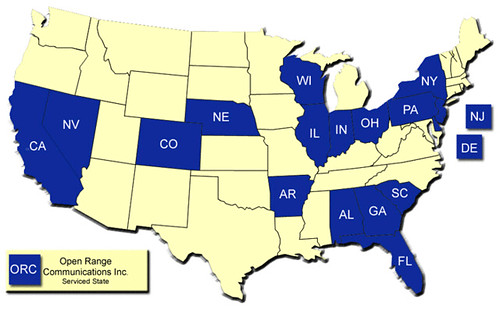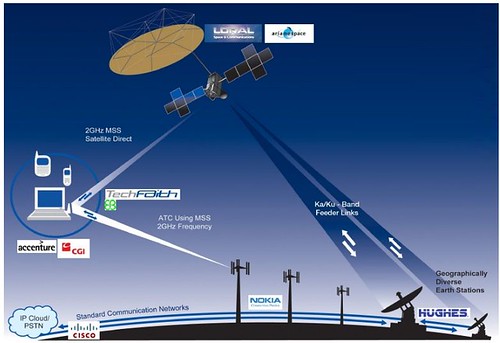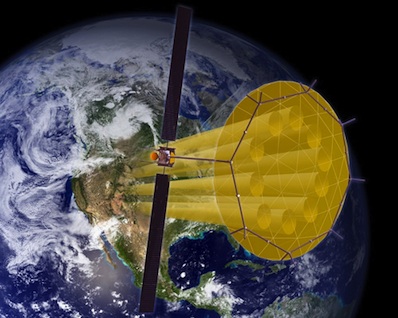MSS: Stuck in Space
Posted by Sam Churchill on December 10th, 2010In May 2009, I wrote optimistically about the expected resurgence of the mobile satellite service (MSS) business. Well, it didn’t happen. Not only that, butGlobalstar recently had part of its satellite authorization yanked by the FCC. The fallout from that FCC decision may cause a huge default in the federal broadband stimulus funding, resulting in a big political mess.
Globalstar is the only MSS operator that did deploy ATC service – at least sort of. What Globalstar did was to lease terrestrial spectrum capacity to Open Range Communications, which then went to the Agriculture Department’s Rural Utilities Service (RUS) for a broadband stimulus loan. And based on their deal with Globalstar and their plan to deploy WiMAX technology in 546 rural areas, they got the loan – to the tune of $266 million.While that was going on, Globalstar was at the FCC asking for waivers of some of the FCC ATC rules. The FCC insists that the terrestrial ATC service be “ancillary” to the satellite service, and the Commission has a number of rules in place to make sure that the spectrum is not used for a solely terrestrial mobile service.Globalstar’s existing satellites could not meet those requirements, but it promised that it would have a new system of 24 satellites deployed by July 1, 2010, that could. So in 2008, the FCC granted Globalstar a 16-month waiver of the ATC rules.But the new system has not been launched. The FCC found that the real cause for delay was that Globalstar ran into financing problems and failed to make payments to Thales for several months, so Thales accordingly slowed work.A further complicating factor is that the existing Globalstar satellites are broken. The Globalstar system uses spectrum around 1610 MHz (“L-band”) for uplinks and 2490 MHz (“S-band”) for downlinks. But the S-band transmitters on the satellites have become “increasingly impacted by degradation.” That is to say that there are periods of time each day, at any given location, where they don’t work.Then in December 2009, Globalstar revealed the satellite launch delays to the FCC and asked for an additional 16-month waiver of the ATC requirements. In mid-September 2010, the FCC came back with a loud “NO” and revoked Globalstar’s ATC authorization, which had the effect of canceling the spectrum lease.The FCC gave Open Range until January 2011 to continue in operation while it finds other spectrum to use.
Globalstar service has been on a downward spiral service degradation caused from radiation. GlobalStar planned to re-use some of their satphone frequencies on terrestrial towers — but the spectrum is supposed to be “ancillary” not “in lieu of” satellite service. Six, 2nd generation Globalstar satellites were launched on Oct 20th.
 A total of four launches of six satellites eachwill be conducted. Globalstar chose Thales Alenia Space to design and deliver 48 second-generation satellites to provide voice and data services. The other satellites in the Globalstar-2 constellation are now under construction at Thales Alenia Space facilities in France and Italy.
A total of four launches of six satellites eachwill be conducted. Globalstar chose Thales Alenia Space to design and deliver 48 second-generation satellites to provide voice and data services. The other satellites in the Globalstar-2 constellation are now under construction at Thales Alenia Space facilities in France and Italy.Globalstar was assigned the 1610-1615.5 MHz and 2487.5-2493 MHz band for Globalstar ATC. The FCC modified Globalstar’s license to permit use of WiMAX, allowing Open Range Communications to deploy their rural broadband service. Globalstar holds a space station license for the Globalstar 1.6/2.4 GHz MSS system via Low Earth Orbit satellites.
FCC rulemaking permits Mobile Satellite Service (MSS) licensees in the 2 GHz (1990-2025 MHz and 2165-2200 MHz) bands (where ICO and Terrastar operate), the L-band (1525-1544 MHz/1545-1559 MHz) and 1626.5-1645.5 MHz/1646.5-1660.5 MHz) bands (where Inmarsat and Skyterra operate), and the “Big LEO” (1610-1626.5 MHz and 2483.5-2500 MHz) bands (where Globalstar and Iridium operate).
- ATC authority would potentially allow Globalstar to use 11 MHz of its 1.6/2.4 GHz satellite radio frequencies for a complementary terrestrial wireless service.
- ATC authority will allow ICO to use about half of its 20 megahertz (2010-2020 MHz and 2180-2190 MHz), for two-way terrestrial communications (pdf).
- ATC authority will allow Skyterra to use about half of its 20 megahertz (2000-2010 MHz and 2190-2200 MHz). Their TerreStar-1 planned to use Nokia Siemens to provide I-HSPA gear for the terrestrial portion of the network which will be deployed as UMTS wideband CDMA.
- LightSquared launched SkyTerra 1 in mid November, 2010 and uses the 1.6 GHz band (with 10 MHz available for ATC-based LTE service).
Globalstar and Iridium are the two LEO constellations. TerreStar, Lightsquared and ICO are geosynchronous satellite platforms.
LightSquared of Reston, Virginia, launched SkyTerra 1 in mid November, 2010. The craft is one of two that will provide satphone service in the second half of next year from startup LightSquared.
The first order of business for Lightsquared is to get their massive antenna unfurled. Their 22-meter (72 feet) L-band reflector-based antenna — the largest commercial antenna reflector to be put into service – is currently stuck.
LightSquared’s plans for a ground-based cellular network that will include approximately 40,000 base stations. About 10 MHz of their 20 MHz bandwidth would be devoted to 1.6GHz LTE service — if they find an interested party to build the nationwide network.
The FCC initially proposed opening up the 90MHz of spectrum as part of its National Broadband Plan. The 90MHz chunk of spectrum is the second largest that the FCC is seeking to open as part of its national plan, after the 120MHz from broadcast TV airwaves.
In May, the Commission made another 25MHz of satellite spectrum available for mobile broadband by changing its Wireless Communications Service (WCS) rules.
source: dailywireless.org






No comments:
Post a Comment